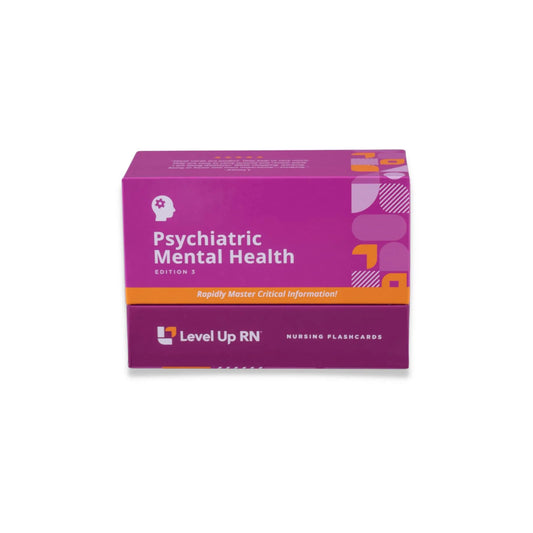Psychiatric Mental Health - Nursing Flashcards
This article covers the non-pharmacological therapies electroconvulsive therapy (ECT) and vagus nerve stimulation (VNS).
You can follow along with this series using our Psychiatric Mental Health Nursing Flashcards, which are intended to help RN and PN nursing students study for nursing school exams, including the ATI, HESI, and NCLEX.
Electroconvulsive therapy (ECT)
Electroconvulsive therapy or ECT is the use of an electrical current to the brain to create generalized cerebral seizure under general anesthesia. This increases the levels of neurotransmitters such as dopamine, serotonin, and norepinephrine.
ECT is indicated for severe depression that is resistant to antidepressants.
It can also be used to treat schizophrenia and mania associated with bipolar disorder.
ECT is contraindicated when there is increased intracranial pressure (ICP).
ECT procedure
ECT delivers an electrical stimulus through electrodes that are attached to the patient's temple.
Additionally, a number of medications are administered to the patient during this procedure, including:
- Anticholinergics, such as atropine, to help decrease secretions
- Anesthetic agents (e.g., methohexital or propofol) because the patient is under general anesthesia for ECT
- Neuromuscular blocking agent, such as succinylcholine, to help decrease muscle contractions in order to prevent injury to the patient during the procedure
Side effects of ECT
The side effects of ECT can include short-term memory loss and confusion.
ECT nursing care
Electroconvulsive therapy is an invasive procedure, so informed consent must be obtained from the patient prior to the procedure.
The patient should be NPO (fasting) for six to eight hours before ECT.
If the patient is taking anti-seizure medications (anticonvulsants), these should be discontinued before commencing ECT. Remember: ECT is a procedure in which we are trying to generate a seizure in the patient.
During electroconvulsive therapy, it's important to continuously monitor the patient's vital signs, their EEG, and their EKG.
It is also important to hyperventilate the patient (to enhance seizures and to increase patient’s safety) before and after the procedure.
Patient teaching for ECT
The patient should be taught that they may experience short-term memory loss and confusion, which is to be expected with this procedure. Patients should also understand that 6 to 12 treatments are usually needed, and that they are usually administered three times a week.
Vagus nerve stimulation (VNS)
The vagus nerve (cranial nerve X) is the longest cranial nerve in the body, containing both motor and sensory functions. The nerve travels widely throughout the body, affecting several organ systems and regions of the body, such as the tongue, pharynx, heart, and gastrointestinal system.
VNS procedure
Vagus nerve stimulation, or VNS is a procedure where a device is surgically implanted under the patient’s skin on the left side of the chest. This device delivers electrical pulses to the vagus nerve at five-minute intervals, approximately. This helps to alter the levels of neurotransmitters in the brain.
Like ECT, vagus nerve stimulation is an invasive procedure and is indicated for treatment-resistant depression. It may also be used for epilepsy (recurring seizures).
Side effects of VNS
The side effects of VNS can include hoarseness as well as cough, because the vagus nerve controls the pharynx and larynx muscles.
It is also possible that the patient may experience a tingling sensation over the implantation device.
Patient teaching for VNS
Teach the patient that the VNS device can be deactivated by holding a magnet over the implant in the chest.
Also, the device is intended to be used along with antidepressants, which means it is important to teach the patient that they should not discontinue their antidepressant medications — VNS and the medications are working together.


